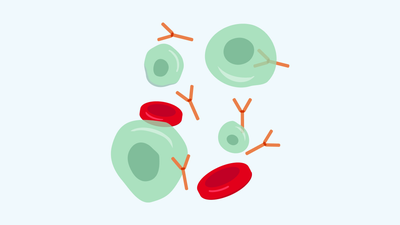Lymphoma
Lymphomas constitute a large and diverse group of neoplasms originating from the lymphoid system.
Characteristics
Under the influence of various factors, cells may undergo cancerous transformations, leading to the abnormal and uncontrolled proliferation of mutated cell lines. The cells of the lymphatic system that most often undergo neoplastic transformations are B lymphocytes, T lymphocytes and NK cells (natural cytotoxic, or natural killer, cells).
Depending on which cells in the lymphatic system the cancer originates from, it can cause different symptoms and affect different organs. Among lymphomas there are non-Hodgkin lymphoma (NHL) and Hodgkin lymphoma (HL).
Considering the dynamics of disease development, non-Hodgkin lymphoma can be divided into:
- slow-growing lymphoma (the so-called indolent lymphoma) - e.g. follicular lymphoma.
- aggressive lymphoma, e.g. diffuse large B-cell lymphoma (DLBCL).
- very aggressive lymphoma (e.g. Burkitt lymphoma).
Non-Hodgkin lymphomas are ranked 6th among malignant cancers in terms of cancer morbidity and mortality. Hodgkin lymphoma, on the other hand, accounts for about 0.5% of all malignant neoplasms with the incidence of 2-3 people per 100,000 per year. For that disease two peaks of morbidity are observed - third decade of life and after 50 years of age.
Causes
As with other cancers, the exact cause of development is unknown. Most often, there are at least a few causes, both from genetic and environmental factors – known as multi-factorial and complex etiopathogenesis.
Nevertheless, in some cases of lymphoma, there are certain recognised risk factors for the disease. They can be divided into environmental, occupational, infection-related, immunological and iatrogenic. Sometimes genetic factors can play a decisive role.
A higher incidence of lymphoma is observed in those who work within the chemical industry - especially rubber and petrochemical workers, as well as farmers and people exposed to pesticides, herbicides, benzene, asbestos and ionising radiation.
Among the infectious agents that contribute to the incidence of lymphoma are EBV (Epstein Barr) and human immunodeficiency virus (HIV) infections.
Immunosuppression and immunodeficiencies of various etiologies are also very important factors that increase the risk of lymphatic system cancers.
Elevated risks are also present in people who have received chemotherapeutic treatment for other cancers in the past.
Symptoms
To diagnose lymphoma it is necessary to perform a histopathological examination of the entire pathologically affected lymph node or a fragment of the affected tissue. Microscopic examination is necessary and in addition to the standard histopathological evaluation, immunophenotyping is performed to more accurately determine the type/subtype of lymphoma.
In addition, if lymphoma is suspected or diagnosed, imaging is also performed to determine the severity of the disease, e.g., abdominal ultrasonography, radiological examination (X-ray, computed tomography). Currently, PET/CT (positron emission tomography) with fluorodeoxyglucose (FDG) is often used to determine the severity of the disease and to monitor the effects of treatment.
Upon diagnosis of the disease, the prognosis is usually estimated taking into account prognostic factors.
Clinical severity of lymphomas is determined using the Ann Arbor staging - Table 2. Grades I and II are often referred to jointly as limited severity, while grade II with extensive nodular mass (the so-called bulky), grade III, and IV are referred to as extensive disease.
The presence of general symptoms of the disease, i.e., fever above 38 degrees for at least two weeks, night sweats, weight loss >10% in no more than six months is designated by letter B and their absence by letter A.
The clinical severity of lymphomas according to Ann Arbor is shown in the table.
Clinical symptoms can be very diverse. In many cases the most common clinical symptom is painless enlargement of lymph nodes.
Signs that should give rise to oncological concern include:
- Painless lymph node enlargement
- Node diameter >2 cm
- Tendency to grow into so-called packs
- Unchanged skin covering pathologically altered lymph nodes
- A spontaneous partial reduction in lymph node size may occur, which may sometimes delay a doctor's appointment
- Pain in the lymph nodes after alcohol consumption (occurs in some Hodgkin lymphoma patients)
When the affected lymph nodes press on different structures, symptoms such as dyspnea (shortness of breath), redness and swelling of the face (superior vena cava syndrome) ascites and swollen lower limbs (in the case of enlarged abdominal nodes) may appear.
Additionally, other symptoms that might appear are:
- Abdominal pains.
- Bleeding from e.g. digestive tract, mucous membranes, nose.
- Hepatitis.
- Skin lesions.
- Skin itching (in some Hodgkin lymphoma patients).
- Neurological symptoms - e.g. caused by nerve compression or presence of pathological mass within central nervous system.
Some patients may also experience general symptoms of the disease, known as B symptoms:
- Fever >38 degrees.
- Night sweats.
- Weight loss >10%.
If the bone marrow is affected, abnormal blood results are usually seen - peripheral blood morphology showing increased leukocytosis and anaemia and thrombocytopenia.
Treatment
Treatment depends primarily on the type of lymphoma. The basic method of treatment is chemotherapy, along with several drugs.
Despite the significant improvement of lymphatic cancer treatment results and the use of different drug combinations and bone marrow transplantation, a fully satisfactory method of non-Hodgkin lymphoma therapy has not been found yet. It is different for Hodgkin lymphoma, where aggressive chemotherapy and radiotherapy significantly change the course of the disease and improve prognosis. Hodgkin disease detected in its early phase is curable in almost 90-95% of cases, whereas non-Hodgkin lymphomas see a 40-70% cure rate.


